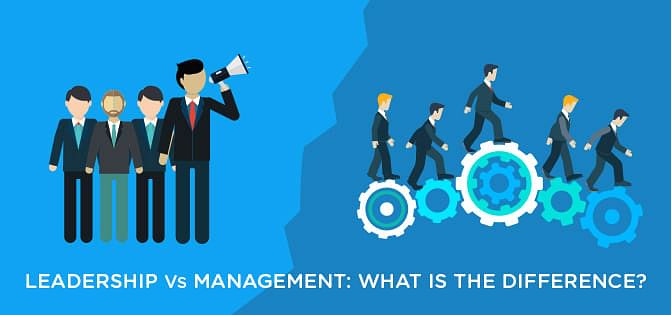Leadership vs. Management

Figure 1: Leadership vs Management
Source: Google
‘There is no single ideal, as the best approach may vary according to circumstances and individual characteristics.’ – CMI (2013).
In response to the above statement, I would strongly agree that the command and control method which is practiced in the past still exist in selected organizations. However, leaders and managers are encouraged to have a more approachable method to overcome varying situations.
Leadership and Management overlap in the sense of sharing similar duties which consist of working with people and influencing others to achieve goals, however, are two different functions. Leadership focuses on developing a vision, setting a direction, advocating change and encouraging new functions towards meeting long-term goals (Bohoris et al. n.d.). The leadership process aligns people with the vision which was developed through effective communication and motivates them through empowerment and basic need fulfillment (Lunenburg 2011).
On the other hand, management focuses on deciding what should be done and getting other people to do it (Mullins et al. 2013). The management process involves planning and budgeting, organizing and staffing, controlling and monitoring activities as well as problem-solving to achieve organizational goals (Lunenburg 2011). Additionally, a good management makes use of its resources efficiently as well as pays attention to the development of its people.
Leaders and managers are distinct with regards to their values and personalities. Leaders value innovation, adaptation, and flexibility (Yuki 2013). They are concerned about the people working for them and the economic outcome as they look into the long-term effect of their objectives and strategies (Yuki 2013). Leaders care about what things mean to people and try to influence these people to a consensus about the most vital things to be done (Yuki 2013). Managers value stability, order, and efficiency (Yuki 2013). Additionally, are risk-averse when it comes to problem-solving, focused on short-term results and they provide expected results consistently to meet stakeholder demands and leadership needs (Bohoris et al. n.d.).
Leadership Styles

Figure 2: Leadership Styles
Source: Google
There are many dimensions to leadership and various leadership styles which exist in an organization. The vision, culture, and goals of an organization could determine what style of leadership suits best. The different leadership styles comprise of the authoritarian, democratic and the laissez-faire (genuine) style (Mullins et al. 2013). All of these leadership styles have their own way of determining policies and implementation of new systems and procedures.
The authoritarian style gives managers the power to decide and solely make decisions without the employees having an option of voicing out their opinions and suggestions (Mullins et al. 2013). The democratic style encourages the participation of the entire group as a whole in decision-making which leads to greater interaction among the group members (Mullins et al. 2013).
The laissez-faire style provides freedom to the employees to act in their best interest and not interfere unless help is needed (Mullins et al. 2013).
In my opinion, I believe that the most effective approach to managing the work of subordinates is the democratic (participative) style. This approach gives the employees a sense of belonging and allows them to participate in decision-making whereby new ideas are proposed and discussed. A diversified workforce would be an added advantage to this type of leadership approach as individual talents, creativity and experiences would enhance the pool of ideas leading to good decisions being made. Although the final decision belongs to the top management of the organization, employees would rather feel appreciated for being part of the organization’s development.
The democratic style would not work so well if team members lack adequate skills needed to provide solutions to specific problems or are prohibited from finding out classified information that can’t be shared with the team in order to make a decision (Murdock 2014).
Examples of Leaders Using the Democratic Approach
James F. Parker
 .
.
Figure 3: James F. Parker
Source: The Buffalo News
James F. Parker was the CEO of Southwest Airlines in 2001 and has portrayed great leadership throughout one of the ultimate crisis the U.S. airline industry had ever faced (Glynn 2014). The 9/11 terrorist attacks caused airlines to be grounded and Parker decided to provide a refund to the customers in which if customers demand for refunds, the airlines would exhaust all its money to stay in business. The outcome turned out to be positive for Parker as some loyal customers sent money back to the airline with the intention of helping the company (Glynn 2014). Southwest airlines did not retrench its employees or cut their pay during this crisis but instead went all out to resolve this crisis with great team work (Glynn 2014).
In addition, the company also made a planned contribution of $179millon to an employee profit-sharing plan (Glynn 2014). Despite challenging times, the company still made money in the final quarter of 2001. Parker strongly believes that the success of Southwest airlines partially lies in the hands of its employees due to their team work towards achieving the goal of serving customers instead of focusing strictly on doing their own jobs (Glynn 2014). Parker also believes that an effective leader would create an atmosphere whereby employees are proud of their jobs, understand the mission of the company and want to do the right thing (Glynn 2014).
Jack Stahl

Figure 4: Jack Stahl
Source: Google
Jack Stahl was the former CEO of Coca-Cola and Revlon. Stahl learned that working with others is the best way to work as he knows how to delegate work to their employees to get a job done but at the same time take a step back when it’s necessary. Given the fact that Stahl simultaneously gives importance to his employees’ views and used his knowledge hands on propelled these two companies to greater heights (Nayab et al. 2011).
Conclusion
A well-balanced organization should have a mix of leaders and managers to be successful as both leadership and management play a vital role towards achieving organizational goals and are complementary to one another (Algahtani 2014). A strong leadership and management would enable an organization to reach its optimal effectiveness (Algahtani 2014).
945 words
References
Algahtani, D. (2014) Are Leadership And Management Different? A Review [online] 2nd edn. American Research Institute for Policy Development. available from <http://jmppnet.com/journals/jmpp/Vol_2_No_3_September_2014/4.pdf> [2 March 2017]
Bohoris, G. and Vorria, E. (n.d.) Leadership Vs Management A Business Excellence / Performance Management View [online] 1st edn. LUND University. available from <http://www.ep.liu.se/ecp/026/076/ecp0726076.pdf> [2 March 2017]
CMI (2013) Understanding Management Style Checklist 236, Chartered Management Institute: London
Glynn, M. (2014) Ex-Southwest Airlines CEO Offers Lessons In Leadership From Post-9/11 Crisis – The Buffalo News [online] available from <http://buffalonews.com/2014/05/19/ex-southwest-airlines-ceo-offers-lessons-in-leadership-from-post-911-crisis/> [2 March 2017]
Lunenburg, F. (2011) Leadership Versus Management: A Key Distinction—At Least In Theory [online] 14th edn. INTERNATIONAL JOURNAL OF MANAGEMENT, BUSINESS, AND ADMINISTRATION. available from <https://cs.anu.edu.au/courses/comp3120/local_docs/readings/Lunenburg_LeadershipVersusManagement.pdf> [2 March 2017]
Mullins, L. and Christy, G. (2013) Management & Organisational Behaviour. 10th edn. United Kingdom: Pearson Education Limited
MURDOCK, K. (2014) Participative Leadership: What It Is And When It Works Best [online] available from <https://blog.udemy.com/participative-leadership/> [2 March 2017]
Nayab, N. and Edwards, G. (2011) Analyzing 5 Real-World Leadership Scenarios [online] available from <http://www.brighthubpm.com/resource-management/120498-five-real-world-examples-of-successful-leadership/> [2 March 2017]
Yuki, G. (2013) Leadership In Organizations. 8th edn. United Kingdom: Pearson Education Limited
James F. Parker is a good example of leadership. He managed the 9/11 crisis effectively compared to some other airlines. His act of staying in the company to support the people in the company through their tough time is respectable. Thanks for sharing!
LikeLiked by 2 people
Thank you for your feedback. I will have to agree with you that James Parker has been rock solid with his decisions and courage to safeguard the company during the crisis. Great sense of leadership portrayed. Please continue to follow and comment on my blogs.
LikeLike
Well organized blog and effective discussion about the democratic leadership style, and a great linkage between the democratic leader and example given, James F. Parker and Jack Stahl. I share your opinion that a well-balanced organization should have both mixes of leaders and managers style. Keep it up! I’m looking forward to your next blog.
LikeLiked by 1 person
Thank you for the feedback. A good mix of leaders and managers are the key drivers towards an exemplary style of leadership and an effective organizational structure. Please continue to follow my blogs and share your opinions.
LikeLike
Good write up and choice of examples to fit the democratic leadership style. It was interesting to read on the leaders chosen. I do agree with you that each organization should balance between both leaders and managers as they do overlap to a certain extent. Thank you for sharing.
LikeLiked by 1 person
That is true, leaders and managers overlap in terms of dealing with the people factor, however, play distinct roles to serve their respective purpose. Thank you for the feedback. Please continue to follow my blogs and share opinions.
LikeLike
Good write-up with well explanation on the overall topic. good job.
LikeLiked by 1 person
Thank you. Please continue to follow my blogs and provide feedback.
LikeLike
Agreed on democratic style leadership is an effective way to lead people because it encourages the relationship between leaders and their followers in making decisions but somehow limitations such as timing in making decision comes to play. You need the majority voices before making a decision.
LikeLiked by 1 person
Employees would feel inclusive and appreciated when their voices are being heard and opinions being taken into consideration. That way, there would probably be higher chances of a low turn-over rate because employees are happy to work in a particular organization. Appreciate your feedback, thank you. Please continue to follow my blogs and feel free to comment.
LikeLike
Very clear difference given for roles of managers and leaders… Your conclusion is also well structured. Thank you for sharing
LikeLiked by 1 person
Appreciate your feedback, thank you. Please continue to follow my blogs and feel free to comment.
LikeLike
Very well written blog, keep up the hard work. Jack Stahl was the former CEO of Coca-Cola and Revlon, do you think his leadership style was more of a laissez-fair style leadership?
LikeLike
Appreciate your feedback, thank you. In my opinion, Jack Stahl demonstrated the democratic style as he had his stand in the making final decisions and at the same time lending an ear to listen and consider his employee’s opinions.
LikeLike